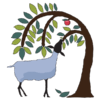Descended from Gutefår
The history of Gotlands date back to the Viking era. It is believed that Gotland sheep are descendants of Gutefår (Gute sheep), whose bloodlines date back in time on a tiny island in the middle of the Baltic Sea, Gotland island. Gotland was a thriving trading center for the Vikings, who transported sheep during their expeditions. Gutefår, a hardy landrace breed of sheep, formed over time as they foraged the unkempt coastline of Gotland. Both Gutefår rams and ewes have horns which majestically curl about their clean faces. Their legs and bellies are free from wool, and faces have that characteristic white nose and white circles around their eyes.
The Modern Day Gotland
Many of the modern European short-tailed breeds of sheep descended from the Gutefår, the modern day Gotland being one of them. A wise shepherd on Gotland island told me that the Gotland breed, as we know it today, began with one farm in the early 1920’s. Wanting sheep with no horns and a higher quality fleece, this farmer pulled a nice looking ram off a train headed for slaughter that had the characteristics he was looking for. He crossbred this ram with his Gute sheep and began selecting and breeding for polled sheep and the characteristic curly gray fleeces of the Gotland Peltsheep (pälsfår) or modern Gotland sheep.
Read Kim’s articles about Gotland sheep in Shepherd Magazine.










